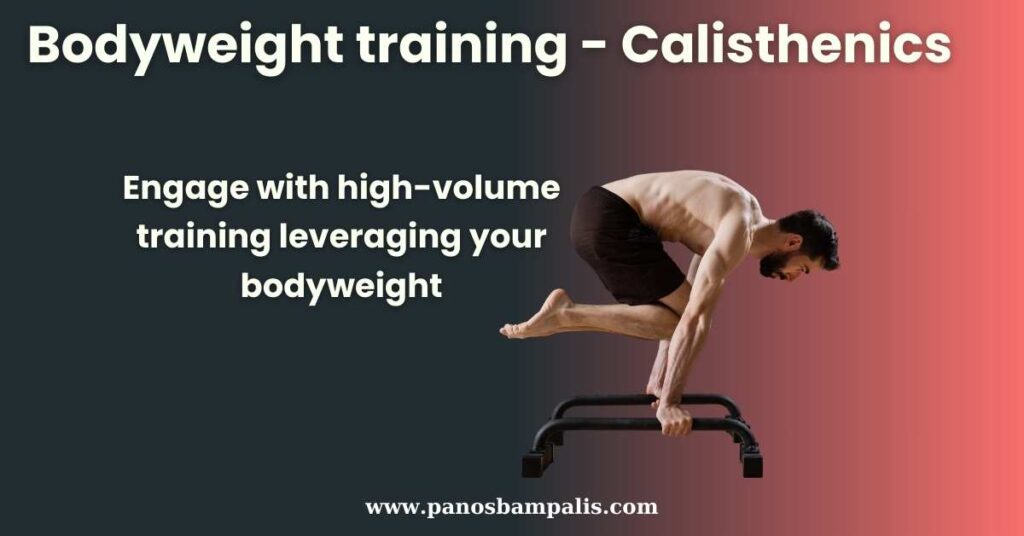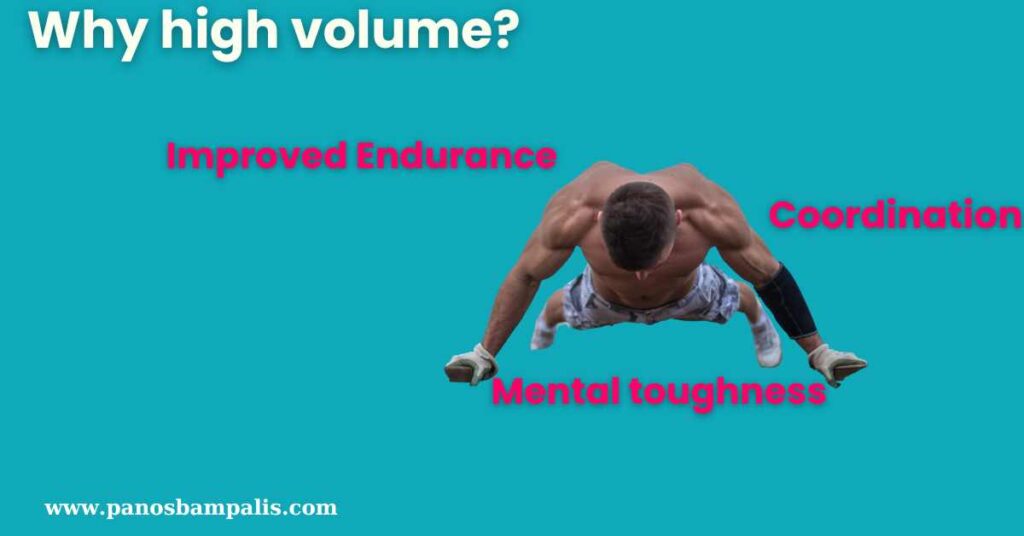Feeling stuck in your workout routine, or maybe you need to see the results you wish?
You’re not alone. It’s a common frustration, especially when you’re pouring in effort, but the mirror seems to mock you.
Here’s the deal: Bodyweight training could be the game-changer you’ve been searching for, especially aiming in high volume workouts.
⚡TL;DR – High Volume Bodyweight Training

We’re diving deep into why switching up your routine to incorporate this method can unlock new levels of strength and physique you didn’t think possible with bodyweight alone.
I’m about to break down the ins and outs of high-volume bodyweight training and show you how to leverage your body to achieve stunning results.
Think less equipment, more gains. Let’s get into it.
What is Considered High Volume Bodyweight Training?
High-volume bodyweight – or calisthenics – training isn’t just your average workout routine. It’s a training method that emphasizes more repetitions and sets to push your muscles to their limits.
The core idea behind this approach is to induce muscle failure through repetitive stress without needing heavy weights or fancy gym equipment. Focusing on calisthenics training, you engage in exercises that use your body weight as resistance, challenging your strength, endurance, and flexibility.
With each session, this method maximizes muscle engagement and endurance, pushing you closer to muscle failure.
Forget lifting the heaviest weights or performing useless limited movements in gym machines.
Let me explain..
When we talk about high volume in bodyweight or calisthenics training, we’re referring to a structured regimen that prioritizes many repetitions and sets to push your body to its limits and beyond effectively.
It’s about consistency, persistence, and gradually increasing your body’s capacity to handle more work.

Engaging with High Volume: The Basics
– Understanding Reps and Sets: High volume usually means doing 2-4 sets of a particular exercise with a high rep range. This could be anything from 20 to 50 reps per set, depending on your fitness level.
– Choosing the Right Exercises: Focus on compound movements like pushups, pullups, dips, and squats. These exercises engage multiple muscle groups and give you the most bang for your buck.
– Balancing Intensity and Rest: While high volume is about pushing limits, listening to your body is crucial. Ensure adequate rest between sets and workouts to prevent overuse injuries.
The Benefits of High Volume Bodyweight – I was Impressed!
The benefits of high volume bodyweight training stretch far beyond what many initially believe possible with such a straightforward training method.
This approach emphasizes pushing your muscles to the brink, commonly known as training to failure. It’s not just about endurance; it’s a form of strength training that targets and fatigues your muscle fibres, leading to significant gains in strength and muscle mass.
By repeatedly challenging your body with high reps and sets of bodyweight exercises, you stimulate adaptation in a way that traditional strength training methods may not. This training method leverages the principle of progressive overload without the need for heavy weights, making it accessible yet incredibly effective.
The result? A stronger, more resilient body is built using the simplest tool available: your own weight.

Why High Volume Rocks
1. Improved Endurance: High-rep training significantly boosts your muscular endurance, enhancing overall athletic performance.
2. Muscle Hypertrophy: More reps mean more time under tension for your muscles, leading to increased muscle growth.
3. Mental Grit: Pushing through those extra reps requires mental toughness. This kind of training builds not just muscle but also character.
Do you Wonder Who is High Volume for?
Here is the answer of your potent question:
High-volume bodyweight training isn’t just for elite athletes; it’s for anyone looking to build strength, increase muscle mass, and incorporate isometric holds to challenge their body in new ways.
Now, there is one more point I need to make: Whether you’re a fitness newbie aiming to lay a solid foundation or an experienced lifter looking to switch things up, this approach is perfect for anyone who want to enhance his condition without the heavy lifting equipment.
You can significantly enhance your strength and muscle endurance by focusing on higher repetitions and leveraging isometric techniques.
Making High Volume Work for You
– For Beginners: Start with basic exercises like bodyweight squats and pushups. Gradually increase your rep count as you get stronger.
– For Intermediate and Advanced: Add more challenging variations, like diamond pushups or pistol squats, and increase your rep range.
AND: Listen to Your Body – High volume can be intense. Pay attention to what your body tells you to avoid injury.

What Equipment is Required?
One of the best things about high-volume bodyweight training is its simplicity. You don’t need a fancy gym or expensive equipment. Your body is your gym! However, a few basic items can enhance your training experience.
Essentials for Effective Training
A Simple High Volume Bodyweight – Calisthenics Workouts
Ready to get started? Here’s a simple yet effective high-volume bodyweight workout plan. Remember, the key is to start at a challenging but doable level and then gradually increase the intensity.
Your Go-To High Volume Workout
1. PushUps: 4 sets of 20-30 reps.
2. Pullups: 3 sets of 15-20 reps.
3. Bodyweight Squats: 4 sets of 25-35 reps.
4. Dips: 3 sets of 20 reps.
Conclusion
In wrapping up, it’s clear that high-volume bodyweight training isn’t just another approach to training; it’s a transformative strategy designed to elevate your overall performance.
You engage in a holistic development that traditional workouts often miss. This method ensures growth in strength and endurance and enhances agility and mobility, making you a more well-rounded athlete.
Frequently Asked Questions: Benefits of High Volume Exercises
1. What are high-volume exercises?
High-volume exercises refer to workouts that involve performing many reps or sets within a training session. These can include bodyweight exercises like pushups, squats, pullups, and more, typically aimed at building endurance and muscle mass.
2. How do high-volume exercises benefit the body?
Engaging in high-volume weight training can aid in muscle building and strength training. Emphasizing high-rep sets, such as bodyweight squats and diamond pushups, helps improve fiber recruitment, leading to enhanced strength and muscle gains over time.
3. Are high-volume exercises effective for building muscle?
Rep bodyweight training and total training volume are key factors in muscle growth. By incorporating exercises like pullups and dips with higher rep ranges, individuals can stimulate muscle fiber development, ultimately aiding in bodybuilding goals.
4. How does high-volume training impact performance?
Consistent volume training can improve overall performance. It challenges the body in new ways and activates both slow-twitch and fast-twitch muscle fibers. This diverse stimulation can enhance strength, endurance, and motor unit recruitment.
5. What is the best approach to high-volume calisthenics?
For those aiming for strength and muscle gains, incorporating high rep calisthenics like 100 pushups and pullups into a well-rounded<!– </b>

